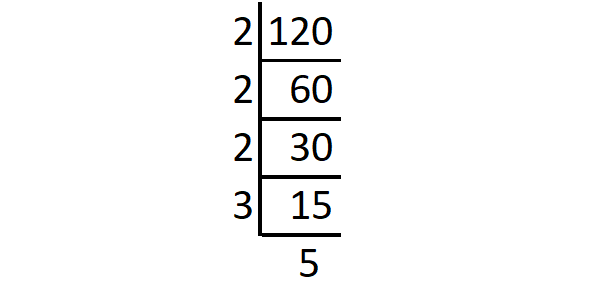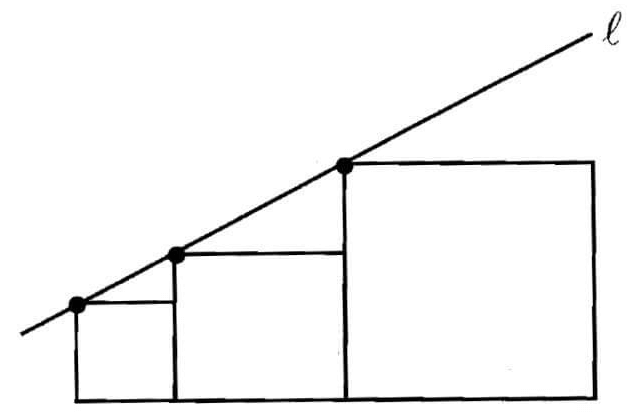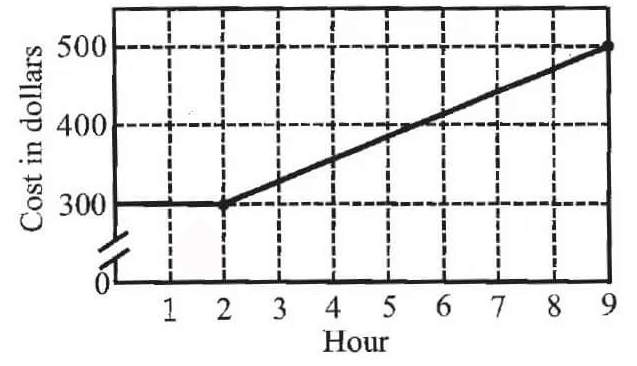SAT MATH QUESTIONS WITH ANSWERS
(Part - 4)
Question 1 :
In three plays, a football team loses 5 yards and then gains 32 yards by completing a pass. Then a penalty was called and the team lost 10 yards. How many yards did the team actually gain?
Answer :
= -5 + 32 - 10
= 17 yards
Question 2 :

On the number line above, if BC = 2AB, find the value x.
Answer :
Length of BC :
BC = C - B
BC = x - (-0.4)
BC = x + 0.4
Length of AB :
AB = B - A
AB = -0.4 - (-1.25)
AB = -0.4 + 1.25
AB = 0.85
Given : BC = 2AB.
x + 0.4 = 2(0.85)
x + 0.4 = 1.7
Subtract 0.4 from both sides.
x = 1.3
Question 3 :
If n > 0, how much is (n + 3) greater than (n - 11)?
(A) 8
(B) 10
(C) 12
(D) 14
Answer :
To know know how much (n + 3) is greater than (n - 11), subtract the smaller value from the greater value.
= (n + 3) - (n - 11)
= n + 3 - n + 11
= 14
Therefore, (n + 3) is greater than (n - 11) by 14.
The correct answer is option (D).
Question 4 :
What number is halfway between -⅚ between ⅓?
(A) -¼
(B) -⅓
(C) -½
(D) -⁵⁄₁₂
Answer :
To find a number which is halfway between -⅚ between ⅓ is to find the average of the given two numbers.
Average of -⅚ and ⅓ :
The correct answer is option (A).
Question 5 :
How many minutes are there in 2h hours and 6m minutes?
(A) 60h + 12m
(B) 120h + 6m
(C) 60h + 6m
(D) 120h + 60m
Answer :
To find the number of minutes in 2h hours and 6m minutes, convert 2h hours to minutes.
Since 1 hour = 60 minutes, we have to multiply 2h hours by 60 to convert it to minutes.
2h hours and 6m minutes :
= 2h hours + 6m minutes
= 2h ⋅ 60 minutes + 6m minutes
= 120h minutes + 6m minutes
= (120h + 6m) minutes
The correct answer is option (B).
Question 6 :
If x = 10, what is the value of ˣ⁄₂ + ˣ⁄₂₀ + ˣ⁄₂₀₀?
Answer :
= ˣ⁄₂ + ˣ⁄₂₀ + ˣ⁄₂₀₀
Substitute x = 10.
= ¹⁰⁄₂ + ¹⁰⁄₂₀ + ¹⁰⁄₂₀₀
= 5 + ⁵⁰⁄₁₀₀ + ⁵⁰⁄₁₀₀₀
= 5 + 0.5 + 0.05
= 5.55
Question 7 :
If x and y are positive integers and 2x + 5y = 18, what is the value of x?
Answer :
Since both x and y are posoitve integers,
x = 1, 2, 3,.......
y = 1, 2, 3,.......
We can test the values 1, 2, 3,....... one by one for x.
When x = 1,
2(1) + 5y = 18
2 + 5y = 18
5y = 16
y = ¹⁶⁄₅ (not an integer)
When x = 2,
2(2) + 5y = 18
4 + 5y = 18
5y = 14
y = ¹⁴⁄₅ (not an integer)
When x = 3,
2(3) + 5y = 18
6 + 5y = 18
5y = 12
y = ¹²⁄₅ (not an integer)
When x = 4,
2(4) + 5y = 18
8 + 5y = 18
5y = 10
y = 2 (positive integer)
Therefore,
x = 4
Question 8 :
The sum of four consecutive odd integers is 296. What is the greatest of the four consecutive odd integers?
Answer :
For example, if 5 is the first odd integer, then the four consecutive odd integers are
5, 7, 9, 11
But, we do not the first odd integer. So, we can assume x as the first odd integer. Then the four consecutive integers are
x, x + 2, x + 4, x + 6
Given : The sum of four consecutive odd integers is 296.
x + (x + 2) + (x + 4) + (x + 6) = 296
x + x + 2 + x + 4 + x + 6 = 296
4x + 12 = 296
Subtract 12 from both sides.
4x = 284
Divide both sides by 4.
x = 71
The greatest of four consecutive odd integers :
= x + 6
Substitute x = 71
= 71 + 6
= 77
Verify :
When x = 71, the four consecutive odd integers,
71, 73, 75, 77
Sum of the four consecutive odd integers :
= 71 + 73 + 75 + 77
= 296 (verified)
Question 9 :
The product of four consecutive positive integers is 120. Find the smallest of the four consecutive positive integers.
Answer :
Let us assume the following are the four positive consecutive positive integers.
y, y + 1, y + 2, y + 3
Given : The product of four consecutive positive integers is 120.
y(y + 1)(y + 2)(y + 3) = 120
Solving the above equation for y is a difficult process. Because, if you multiply the terms on the left side, the exponent of y is 4. Try to write 120 as a product of four consecutive positive integers in ascending order (smallest to greatest).
y(y + 1)(y + 2)(y + 3) = 2 ⋅ 60

y(y + 1)(y + 2)(y + 3) = 2 ⋅ 2 ⋅ 2 ⋅ 3 ⋅ 5
y(y + 1)(y + 2)(y + 3) = 2 ⋅ 3 ⋅ (2 ⋅ 2) ⋅ 5
y(y + 1)(y + 2)(y + 3) = 2 ⋅ 3 ⋅ 4 ⋅ 5
Comparing the smallest values on both sides,
y = 2
The smallest of the four consecutive positive integers is 2.
Question 10 :
Find the sum of all three digit numbers which can be formed with the digits 3, 5 and 7, if each digit is used only once in each arrangement.
Answer :
The list of three digit numbers which can be formed with the digits 3, 5 and 7 (each digit is used only once in each arrangement).
357
375
537
573
735
753
Sum of the above three digit numbers is 3330.
Kindly mail your feedback to v4formath@gmail.com
We always appreciate your feedback.
©All rights reserved. onlinemath4all.com
Recent Articles
-
Digital SAT Math Problems and Solutions (Part - 146)
Apr 18, 25 06:52 AM
Digital SAT Math Problems and Solutions (Part - 146) -
Logarithmic Derivative Problems and Solutions
Apr 16, 25 09:25 PM
Logarithmic Derivative Problems and Solutions -
Digital SAT Math Problems and Solutions (Part - 145)
Apr 16, 25 12:35 PM
Digital SAT Math Problems and Solutions (Part - 145)

